
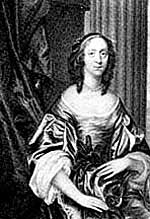 Lucy Hutchinson.
Lucy Hutchinson.Women have made an important contribution to the history of Nottingham despite their absence from the official record. Queen Isabella ( 1295- 1358) wife of Edward II resided in Nottingham Castle for a period of time as Queen Regent as did a lesser known figure Lucy Hutchinson (1620 – 1358) Lucy’s husband was Governor of Nottingham Castle during the English Civil War and was one of the signatories of Charles I death warrant. John Hutchinson was incarcerated following the Restoration of Charles II and he died in captivity in Sandown Castle, Kent. Lucy wrote 'Memoirs of the life of Colonel Hutchinson' to protest his innocence. She was also a translator and poet, and wrote Order and Disorder the first epic poem written in English by a woman.
Of course there were many women from poorer backgrounds who contributed to the growing trades in Nottingham during the Medieval and Early-Modern period circa 1400-1600. Women were involved in the production of wool and cloth, leather and food, but whereas their male counterparts may have gone on to Civic offices women were seen as unimportant.
Through the memoirs, letters and diaries maintained by women residing in Nottingham it is possible to gain an insight into a ‘woman’s lot’ in the 17th and 18th Century. The diary of Abigail Gawthorn (1757-1822) for example provides a written record of the threefold increase in the city’s population and the growth of the slum areas of the Narrow Marsh behind her fine Georgian house on Low Pavement. Abigail was a rich woman acquiring land through the Basford Enclosure Act and she owned eighteen houses in Narrow Marsh. Her diary documents the minutiae of home life with thirteen references to dances, forty three to a Ball and Assemblies and there are also recordings of rioting, executions, funerals, illness and local scandals.
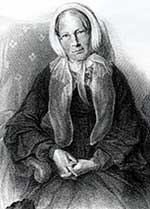
Ann Gilbert.
Until the Poor Law Amendment Act of 1834 women who were unable to support themselves were at the mercy of their local Parish and the overseers- the providers of financial loans with an almost impossible to pay off interest rate. As a result many women turned to prostitution, vagrancy and crime. One of the earliest refuges for ‘unfortunate women’ was established in the 1830s by Ann Gilbert (1782-1866). Ann and her sister Jane were famous for their collection of poems and hymns for young children, Original Poems for Infant Minds (1805) which included ‘Twinkle Twinkle Little Star penned by Jane Gilbert. Ann, also set up the Nottingham Ladies Society for the Relief of Negro Slaves.
Women have formed a significant proportion of Nottingham’s workforce since the expansion of industry in the City in the 18th and 19th century. A tradition which dated back to the rise of stocking knitting which established a demand for female as well as male labour. Thousands of women were employed in the lace trade in the factories and outreach work during this period of time, the finishing for example of lace was sent to women either working at home or in small workshops. When lace manufacturing faded after the First World War, the hosiery and knitwear industry absorbed women and girls into local factories. Additional opportunities for women to work were provided by the further growth of three companies in Nottingham from the 1930s onwards, the Boots Pure Drug Co, Imperial Tobacco (Players) and Raleigh Cycle Co.
Wages and conditions of work in both framework knitting and the lace trade could be very poor and employed many young girls some aged as young as eight as noted in government commissions of enquiry in 1833 (lace trade) and 1844 (framework knitting) and many women were politically aware of their position and actively involved in Luddite protests in 1811 and 1816.
Chartism, the movement founded in 1837 to promote political democracy, was supported by many working class women in Nottingham. This involved women taking an active, public and often turbulent part in meetings and street demonstrations. In 1838 they set up their own organisation, the Nottingham Female Political Union. One of the noted chartist organisers was Mary Ann Abbott who was also responsible for the running of the Chartist Sunday School.
In addition to campaigning for the vote, suffrage for both sexes, women also agitated locally on food prices. One of their campaigning tactics was to exhort women to buy only from shops that supported the peoples’ cause leading the Nottingham Mercury, to report on their: ‘rough manner’ and ‘militant behaviour’ in August 1839. The same newspaper reported that Elizabeth Cresswell a 43 year old framework knitter had been arrested during a riot for carrying a loaded revolver and spare ammunition.
With improving economic conditions in the 1850s the Chartist movement declined and working women looked towards the establishment of their own Trade and Friendly Societies. Female only Friendly Societies were noted in Nottinghamshire county in the early years of the 19th Century. In 1803 there were 23 registered societies for women with a membership of 1,644. These numbers increased significantly during the 1830s and 1840s in response to women’s concern following the implementation of the 1834 Poor Law Amendment Act. Friendly societies provided benefits to members as a right in return for regular subscriptions. To receive financial assistance from a society, to be ‘on the club’ or making a claim ‘on the box’ did not carry the same stigma as seeking support from the local parish or handouts from charitable sources. Benefit payments varied but generally included income in times of sickness, payment to cover funeral expenses and sometimes an allowance in old age. Club membership was a source of female pride and an indicator of respectability. Many of the societies held an annual club feast day which normally was preceded by a procession.
There was renewed activity for the suffrage in Nottingham in 1866 with the first women’s suffrage petition being submitted to the House of Commons in 1869 and in 1881 the Nottingham National Branch of the National Women’s Suffrage Society was formed. Although the activities of this non militant branch of women’s suffrage are still to be recorded formally the branch continued until 1923 when they became the National Union of Societies for Equal Citizenship.
Women and Civic Life
In the late Victorian period middle class women in Nottingham often the wives and daughters of professional men, factory owners and lace manufacturers were increasingly involved in a range of charitable activities. Female philanthropy was mainly organised around helping the poor. This took the form of visiting the homes of poor women and the institutions both public and private that provided for women for example the Workhouse. The life and work of Henrietta Carey (1845-1925) demonstrates the increased involvement in public life by Nottingham women. Henrietta established the Nottingham Town and County Social Guild in 1875 which undertook many charitable works. The Guild provided blanket loans ran a girls club and a cheap dinner scheme for children. Henrietta also established a residential hostel for women working in the city, a club for working women and a dining hall in Trinity Square. Henrietta was very involved in the National Union of Women Workers which was formed in 1895 to provide a platform for women who worked mostly in a voluntary capacity their aim ‘the social, moral and religious elevation of their own sex’.
In the early 20th Century Miriam Kaplowitch née Kaufman continued to develop a number of the schemes that Henrietta had established. Of particular note was the further development of convalescent homes setting these up in Skegness for girls and boys. In addition Miriam laid the foundations for the Nottingham Society for the prevention of cruelty to children and established hostels in the City for children and young Jewish women fleeing from Nazi Germany in the 1930s. The contribution of many Jewish women to the history of Nottingham is detailed in a local study undertaken by the Jewry Research team available in the Angel Row Library.
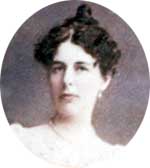
Florence Boot.
Charitable works were also associated with Florence Boot (1863- 1952) wife of Jesse Boot the chemist. Florence was an equal partner in the firm and was concerned about the welfare of their workers and provided breakfast for them before they started work. An enterprising business woman who introduced a Book Lending scheme in the larger Boots shops opening up popular literature in particular for working women. Florence also established a hostel for women students attending University College Nottingham in the 1920s maintaining a life long commitment to women’s education.
Throughout the 19th century Nottingham was a centre for Methodism and non conformist religions and women were very active within this movement. Religion gave women status within the community and allowed them to gain administrative skills. Women tended to undertake the teaching at the Sunday schools and it was their job to educate the next generation into religion. Hannah Guilford (1840-1938) a teacher at High Pavement Sunday School was elected as Chairman of the Chapel Council in 1904, a role normally occupied by men. Another full time religious commitment was sisterhood – a female community of professional religious women. The Convent of Mercy attached to St Barnabas, Catholic Cathedral, both designed by Augustus Pugin (1812-1852) opened in 1845. The convent housed the first catholic religious community in Nottingham since the reformation. The convent was run by a council of four elected sisters and they provided welfare, education and nursing services for local citizens. In 1846 the nuns opened St Catherine’s School in the convent which eventually transferred to Beechdale Road in 1962 and is now known as Trinity School. The convent closed in 1999.
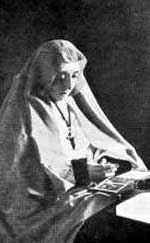
Mary Potter.
The other possibly more well known order was established by Mary Potter (1847-1913) in a dilapidated silk factory in Hyson Green. They were known as the ‘blue nuns’ because of their distinctive blue veil. Their work included teaching the basics of hygiene and child care to the women in the area, visiting people in prison and the workhouse, nursing the sick, praying for the dying , assisting the poor and providing aid to anyone who called at the convent door. During the later half of the nineteenth century her order opened centres around the world. In 1988 Pope John Paul II declared Mary Potter venerable – the first step to being made a saint. Her bones are interred in St Barnabas Cathedral.
At a later date another religious sisterhood emerged to improve the local living conditions of women living in the overcrowded and well documented Nottingham slums of Broad Marsh and Narrow Marsh. The Marsh Sisterhood as they became known was established in 1909 and continued until the slums were demolished in the 1960s. A number of objects of the sisterhood were laid down including encouraging habits of purity, sobriety, cleanliness, industry and morals.
Education for girls in Nottingham was demarcated by social class with limited opportunities for working class girls to receive any post elementary (primary schooling) before the early twentieth century. The formalisation of middle- class girls education came about largely as the result of feminist reformers. The Girls Public Day Trust established the Nottingham High School for girls in 1875 this was originally on Oxford Street before relocating to Arboretum Street to a former Lace Manufacturers House and there were many private day schools for middle class girls in the City itself.
Teaching was one of the few professions open to a woman before the 20th century.
A woman whose contribution to education in Nottingham has been overlooked was Jane Roadknight (1855-1929). In 1885, Jane obtained the post of Kindergarten teacher at the Blue Bell Hill Board schools and went on to become a Kindergarten Instructress to the Nottingham School Board and then to become a highly respected Inspector for the City of Nottingham until her retirement in 1919. Jane introduced continental influences based on the ideas of Friedrich Froebel ( 1782-1852 ) into Nottingham’s schools. In addition to providing teacher training for women on these principles as an extension course attached to Nottingham University College.
State provided education came into being with the passing of the 1870 Education Act and this offered opportunities for women to enter into electoral politics in the form of local School Boards for which rate payers both male and females could vote and on which women could sit.
While election to local office was an important political step for middle class women it was still an extension of widely accepted female philanthropy. Hannah Guilford previously referred to was also elected to sit on the Nottingham School Board in 1892 and remained there until 1904 and when it was taken over by the City Council she was co-opted onto the Education committee. A less prestigious position was to serve as Poor Law Guardian which Hannah’s sister Sarah was elected to. The two sisters and their third married sister Ann Cowen were active suffragettes but linked to the less militant arm of the movement led by Millicent Fawcett.
There was an active Women’s Social and Political Union (WSPU) in Nottingham– the break away grouping led by Emmeline and Christabel Pankhurst during the period 1908 to 1924. The most well known suffragette from Nottingham was Helen Watts (1881-1970s). Her family lived in Lenton Vicarage where her father was vicar. Helen was imprisoned in Holloway gaol in 1909 and she spoke at many public meetings on socialist and feminist topics .After she left the WSPU Helen joined the Women’s Freedom League. During the war she nursed at the Mineral Water Hospital, Bath and later worked at the war office and Ministry of Labour before she emigrated to Canada.
Nottingham Women and War
During the war years 1914-1918 and 1939 to 1945 a significant contribution was made by women to the war effort. This was noted especially in the manufacturing of munitions. From 1916 women were involved in the filling of shells a job which placed them at risk from the chemicals and the potential for explosions. The women who worked at the Chilwell factory were given the nickname of Canary Girls as the chemicals they were working with stained their hands and faces yellow. Women munitions workers were named munitionettes and Tommy’s sisters. A memorial was erected on Chetwynd Road to the twenty five women who lost their lives in an explosion at this factory. During the Second World War thousands of women were conscripted to work in munitions in Nottingham in factories such as Raleigh Cycles which switched its manufacturing base. The women who worked there are commemorated in a special publication ‘In which we serve’.
Women and Politics
In the 1918 Representation of the People Act, women over the age of 30 were entitled for the first time to vote in Parliamentary Elections and equal franchise was finally achieved for women aged 21 in 1928. This led to an increased visibility of women as councillors on the Nottingham City Council.In1920 there were three female magistrates the same year as the first woman policeman had been appointed. In 1924 Caroline Weinberg became the first woman to become a Justice of the Peace. In the 1945 local City Elections six female councillors were returned. The committees they served on included traditional areas of interest such as Health, Mental Health, Welfare and Education, alongside other committees such as Pensions, Libraries, Baths and Washhouses, Housing and Rates.
The first female Lord Mayor of Nottingham was the Conservative councillor Ivy Matthews in 1975 and two decades later Sylvia Parsons from the Labour Party took office.Yet despite the fact that women formed the majority of Nottingham’s electorate from 1928 the first woman Member of Parliament for the city, Lillian Greenwood, was not elected until May 2010.
Women’s contribution to Literature/Arts and Sport
The number or women who have contributed to Literature, Arts and Sport in Nottingham has been highlighted research into Women’s History. A few only are mentioned here. The Nottingham born artist Laura Knight (1877-1970) is one of the most important female artists of the 20th Century and her contribution is marked by a Blue Plaque on her family home, Ethel Villas, opposite the Forest Recreation ground on Noel Street. The Nottingham Castle Art Gallery has ten paintings by Laura Knight and in the 1980s was the venue of the first major retrospective exhibition of Women’s Art in England covering the period 1550-1970.
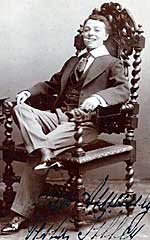
Vesta Tilley.
The stage career of the male impersonator Vesta Tilley (1864-1952) began in Nottingham, promoted by her father who was the stage manager at St George’s Music Hall on Parliament Street. Vesta whose real name was Matilda Alice Powles had a career which spanned forty years and she was the toast of the British music hall singing ‘masher’ or ‘dandy’ songs, like ‘Burlington Bertie’. Vesta first wore men’s clothes on stage at the age of five as she felt she could ‘express myself better if dressed as a boy’. She challenged contemporary notions of gender roles in Victorian society and was popular with women who saw her as a symbol of independence.
In terms of sporting achievement one of the great International tennis stars of the 1930s was Freda James (1911-1988) the daughter of a Nottingham Lace Manufacturer. James with her partner Kay Stammers won two women’s doubles titles at Wimbledon in 1936 and 1937, represented Britain in the Wightman cup, and took the US Open title in 1939. Jayne Torvill, with her partner Christopher Dean will be forever associated with Nottingham for their outstanding performance in the 1984 Sarajevo Winter Olympics, for their figure skating to Ravel’s ‘Bolero’.
A comprehensive overview of Nottingham Women artists, novelist, poets, actors and sportswomen can be found on the following website: www.nottinghamwomenshistory.org.uk.
References
- Anne Bloomfield (2000) Chapter 10, Mrs Roadknight Reports, Jane Roadknight’s Visionary Role in Transforming Elementary Education in Practical Visionaries, Women, Education and Social Progress 1790-1830, Mary Hilton and Pam Hirsch Editors, Pearson Education, England
- Samantha Clements (2008) Feminism, Citizenship and Social Activity: The role and Importance of Local Women’s Organisations, Nottingham 1918-1969, Unpublished Dissertation, University of Nottingham.
- Elizabeth Crawford (2008) The Women’s Suffrage Movement a Reference Guide, 1866-1928, Routledge, London.
- Terry Fry (2003) Henrietta Carey – Artistic Social Worker, The Nottinghamshire Historian, Spring/Summer Edition.
- Nelson Fisher (2008) 8 Hundred Years, the Story of Nottingham Jews, Goaters, Nottingham
- Adrian Henstock, Editor The Diary of Abigail Gawthern of Nottingham, 1751-1810, Thoroton Society, Record Series, 33.
- Robert Mellors (1924) Men of Nottingham and Nottinghamshire
- Julie O’Neill (2001) In the club, Female Friendly Societies in Nottinghamshire, Trent Valley History Group.
- Maureen Rushton (2008) The Canary Girls of Chilwell, Beeston and District Local History Society.
- Dorothy Thompson (1993) Chapter 7, Women Chartists in Outsiders, Class, Gender and Nation, Verso, London.
- Christopher Weir (1989) Women’s History in the Nottinghamshire Archives Office 1550-1950, Nottinghamshire County Council.
- Helen Watts sourced from www.spartacus.schoolnet.co.uk
- Mary Potter, Florence Boot, Lucy Hutchinson detail sourced from Oxford Dictionary of National Biography www.oxforddnb.com/articles
- Women of Nottingham, Nottingham Women’s History Group (2011) available from
www.nottinghamwomenshistory.org.uk - Wood, V., Trafford, S., Sands, K. and Edlin-White, R. (editor), Nottingham Women in WW1, Smallprint, 2014